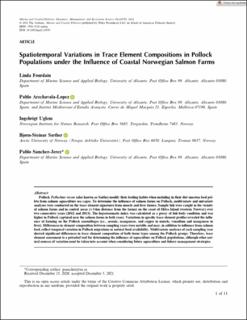Spatiotemporal Variations in Trace Element Compositions in Pollock Populations under the Influence of Coastal Norwegian Salmon Farms
Fourdain, Linda; Arechavala-Lopez, Pablo; Uglem, Ingebrigt; Sæther, Bjørn-Steinar; Sanchez-Jerez, Pablo
Peer reviewed, Journal article
Published version

Åpne
Permanent lenke
https://hdl.handle.net/11250/3010629Utgivelsesdato
2022Metadata
Vis full innførselSamlinger
- Publikasjoner fra CRIStin - NINA [2364]
- Scientific publications [1392]
Originalversjon
10.1002/mcf2.10193Sammendrag
Pollock Pollachius virens (also known as Saithe) modify their feeding habits when including in their diet uneaten feed pellets from salmon aquaculture sea cages. To determine the influence of salmon farms on Pollock, multivariate and univariate
analyses were conducted on the trace element signatures from muscle and liver tissues. Sample fish were caught in the vicinity of salmon farms and in control areas (>3-km distance from the farms) on the coast of Hitra Island (western Norway) over two consecutive years (2012 and 2013). The hepatosomatic index was calculated as a proxy of fish body condition and was higher in Pollock captured near the salmon farms in both years. Variations in specific trace element profiles revealed the influence of farming on the Pollock assemblages (i.e., arsenic, manganese, and copper in muscle; vanadium and manganese in
liver). Differences in element composition between sampling years were notable and may, in addition to influence from salmon feed, reflect temporal variation in Pollock migrations or natural food availability. Multivariate analyses of each sampling year showed significant differences in trace element composition of both tissue types among the Pollock groups. Therefore, trace element assessment is a potential tool for determining the influence of aquaculture on Pollock populations, although other natural sources of variation must be taken into account when considering future aquaculture and fishery management strategies.
